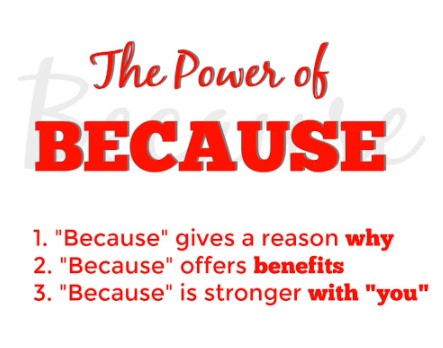Psychology is a scientific branch that you should consider utilising for your copy. Getting into your audience’s minds assists with their response to your words and prompts a call-to-action. Here are 11 psychological techniques you can use when applying science to copywriting:
01. Illusory Truth Effect
This effect is one you can use to circumvent your audience’s decision-making process. Subliminally, repeating an idea numerous times helps to convince a reader’s brain that it is the truth. The Decision Lab states that the following:
“The Illusory Truth Effect describes how, when we hear the same false information repeated again and again, we often come to believe it is true.”
Make no mistake, I’m not advocating repeating false information in your copy at all, but the repetition of any information, true or false, will create the same response.
Reputable writer and lecturer Dale Carnegie famously stated:
“Tell the audience what you’re going to say, say it; then tell them what you’ve said.”
By the time of his death in 1955, Carnegie’s 1936 book “How to Win Friends & Influence People” had sold five million copies in 31 different languages, and 450,000 people had graduated from the Dale Carnegie Institute. I guess he knew what he was talking about.
02. Rhyming
Scientific study has revealed that the use of rhyme influences a person’s perception of accuracy as it enables words and statements to be processed more naturally by the brain. The results of a study released by M.S. McGlone and J. Tofighbakhsh in 2000 suggests:
“…that rhyme, like repetition, affords statements an enhancement in processing fluency that can be misattributed to heightened conviction about their truthfulness.”
Truths told in a way that rhymes will stay… fresh in the mind for another day.

03. Cognitive Fluency
Cognitive Fluency relates to how your brain comprehends something. If copy is easier to understand, it is more cognitively fluent than copy that is more difficult to relate to. If your brain understands something you are more likely to believe it than if you cannot decipher its meaning. Roger Dooley of Forbes describes cognitive fluency as:
“…how scientists describe the ease with which our brains process information. Items that are easily processed are considered “fluent.” The importance to marketers goes beyond mere speed of taking in the information. For things like names, brands, etc., our brains confuse ease of processing with preference and familiarity. And, when we read instructions, the ease with which we process those instructions translates directly into how easy we think the task itself will be!”
Try to write like people think. Make a clear distinction between using confusing jargon and industry-related phrases in your copy and exercise UX copywriting skills to soften technical terms for easier comprehension. Remember that more clarity will mean more persuasion.
04. Positive Emotions
A number of potential sources erroneously suggest using “mental triggers” in your copy. From a psychological perspective these types of triggers are regarded in a negative light so I prefer to suggest targeting positive emotions to psychologically promote your brand with your copy. Prof. Barbara Fredrickson, a leading scholar within social psychology, affective science (the study of emotion), and positive psychology, states the following with her “Broaden and Build Theory” of positive emotions:
“…these positive emotions broaden an individual’s momentary thought-action repertoire: joy sparks the urge to play, interest sparks the urge to explore, contentment sparks the urge to savour and integrate, and love sparks a recurring cycle of each of these urges within safe, close relationships.”
Attempt to build emotional bonds with your audience through your copy. Focus on your product’s benefits instead of its features. Use language that can be easily understood in your headlines. Be authentic and credible. Relate to your reader by instilling an interest which encourages further exploration that will ultimately lead to contentment, joy and yes, ideally, love.
05. Narrative Transportation
In layman’s terms you could better understand Narrative Transportation as becoming engrossed in a great story. Storytelling is an art form in itself, and being able to apply this to your content is likely to improve your conversion chances. Narratives have a capacity to directly influence beliefs and increase the potential of a reader to embrace suggestion. Melanie C. Green and Timothy C. Brock, in their 2000 paper, “The Role of Transportation in the Persuasiveness of Public Narratives”, state the following:
“…individuals reading stories may become transported into a narrative world. Transportation is a convergent mental process, a focusing of attention, that may occur in response to either fiction or nonfiction. The components of transportation include emotional reactions, mental imagery, and a loss of access to real-world information; the resulting transportation may be a mechanism for narrative-based belief change.”
By applying great storytelling techniques to your content, you are able to improve your audience’s receptiveness and understanding to something that may otherwise be difficult and more tedious to read. Your call-to-action at your story’s end will also be more well received.

06. BYAF
“But You Are Free” is a way to subliminally coax an action from your audience. By suggesting that they are welcome to look at other alternatives, for example, you are displaying a confidence that, no matter where or what else your reader investigates, they will ultimately return to you. It also suggests a way out and eliminates the ‘guilt factor’ from the scenario which, in itself, will portray you in a more positive light. Christopher J. Carpenter wrote “A Meta-Analysis of the Effectiveness of the “But You Are Free” Compliance-Gaining Technique” in 2012. He states:
“The “but you are free” (BYAF) compliance-gaining technique operates by telling the target that he or she is free to refuse the request. A meta-analysis of 42 studies of the effectiveness of that technique indicated that it was an effective means of increasing compliance rates in most contexts. It was effective regardless of type of request, but effectiveness diminished when the decision to enact the target behavior was not made immediately, consistent with a self-presentation explanation of the technique’s effectiveness.”
The 42 studies he referred to involved 22,000 participants, with nearly 50% reacting favourably to the suggestion. As Carpenter mentions, include BYAF in your original copy as opposed to responding with the suggestion later on but, clearly, you are free to wait until later if you like.
07. Mirror Neurons
Your mirror neurons are the reactionary feelings you experience when observing somebody else feeling something. Laughing when somebody else does. Crying when somebody cries on TV. Humans are built to live empathetically through the words and deeds of others, and tapping into the natural empathy of your audience by relating to their pain points and feelings will enhance the impact of your copy. Neuroscientist Marco Iacoboni, of the University of California, describes the relationship between empathy and mirror neurons as such:
“Empathy plays a fundamental role in our social lives. It allows us to share emotions, experiences, needs, and goals. Not surprisingly, there is much empirical evidence suggesting a strong link between mirror neurons (or some general forms of neuronal mirroring) and empathy.”
By merely suggesting something using the word “imagine”, for example, you can elicit a response from your readers. Creating a scenario for your audience, and being able to invoke their empathy and imagination, will prompt their mirror neurons to react more favourably to your words or images.

08. Serial Position Effect
The Serial Position Effect maintains that the positioning of words in a sentence makes a huge difference to how well they are remembered. Words that are positioned at the beginning and end of sentences are proven to be noticed more, and as such, the correct positioning of key words in your copy can have a profound effect on persuasion and impact. Dr. Saul McLeod, an experienced Psychology teacher and contributor for simplepsychology.org describes the findings of studies of SPE and also from studies of brain-damaged patients as such:
“Experiments show that when participants are presented with a list of words, they tend to remember the first few and last few words and are more likely to forget those in the middle of the list. This is known as the serial position effect. The tendency to recall earlier words is called the primacy effect; the tendency to recall the later words is called the recency effect.”
It makes sense, especially with long paragraphs and for those of you that scan or skim read, that words positioned at the beginning and end of sentences or paragraphs will remain in the memory longer. As such, positioning vital information in these positions could be useful when writing copy or content.
09. The Odd Number Effect
It has been proven that our brains gravitate toward odd numbers as it takes, on average, up to 20% longer to process odd numbers than even ones. As a result, odd numbers are more thought-provoking than their even counterparts. Terence M. Hines, of Pace University, notes the following in his paper “An odd effect: Lengthened reaction times for judgments about odd digits”:
“Eight experiments are reported that first establish and then explicate a serendipitous finding that judgments about whether digits are odd or even take longer for odd than for even digits. The slowing of judgments about odd digits is more pronounced when digit pairs or triples are used, but is still weakly present when a single digit must be classified.”
It stands to reason that using odd numbers in your copy for blog headlines, step-by-step guides, infographics and lists will be beneficial. In addition, being specific with any numeric references in your copy will aid in making them stand out more to your audience. I’m 99.537913 percent sure about this.
10. Justification
Justifying a question or statement in your copy not only provides evidence and authenticity to back up your information, but using a word like “because” also invokes a mental response from your audience. Ellen Langer, Arthur Blank and Benzion Chanowitz conducted a well-known study into the effects of justification in 1978. “The Mindlessness of Ostensibly Thoughtful Action: The Role of ‘Placebic’ Information in Interpersonal Interaction” is probably better known as “The Xerox Study”. They posed 3 questions while in the queue to make copies:
- “Excuse me, I have five pages. May I use the Xerox machine, because I’m in a rush?”
- “Excuse me, I have five pages. May I use the Xerox machine?
- “Excuse me, I have five pages. May I use the Xerox machine, because I have to make copies?”
94% of those in the queues responded well to the first question, 60% responded favourably to the second and 93% responded well to the third. Considering that the two questions which used justification had over 30% more success than the one that didn’t, it makes sense to employ justification as a means to garner positive responses with copy as well. I’d ask you to consider this because it makes sense.
11. P.S. Lines
‘P.S.’ is the last line that your audience will see in your copy and, hence, it is the perfect position for a call-to-action. Sometimes, if visitors are even only scrolling your text, they will be drawn to your P.S. line because its positioning makes it stand out. Recognised core marketing message development copywriter, Casey Demchak, has this to say about using a P.S. line in copy:
“P.S. lines can be used to great effect when you include them at the end of your sales pages, e-blasts, and other marketing content for your book or online programs.”
Whether it be a special offer, a bonus or benefit of some kind, or simply a way of drawing your audience’s attention to another part of your site or to a social media page, make sure that your P.S. line is filled with information that is designed to stand out.
Conclusion
The benefits of using psychology are numerous and applying science to copywriting, if carefully considered and used correctly, can really assist your copy and responses to the same. Psychology is certainly not the exclusive domain of your “shrink” whose couch you may settle down on fortnightly.
P.S. Find out more about Copywriting and our AI Content Generator by visiting our main blog page here. (You noticed this, didn’t you?)
- Technology and the future of books - July 29, 2021
- The benefits and importance of UX writing - July 29, 2021
- Use the science of music as a tool to enhance creative productivity - July 28, 2021
